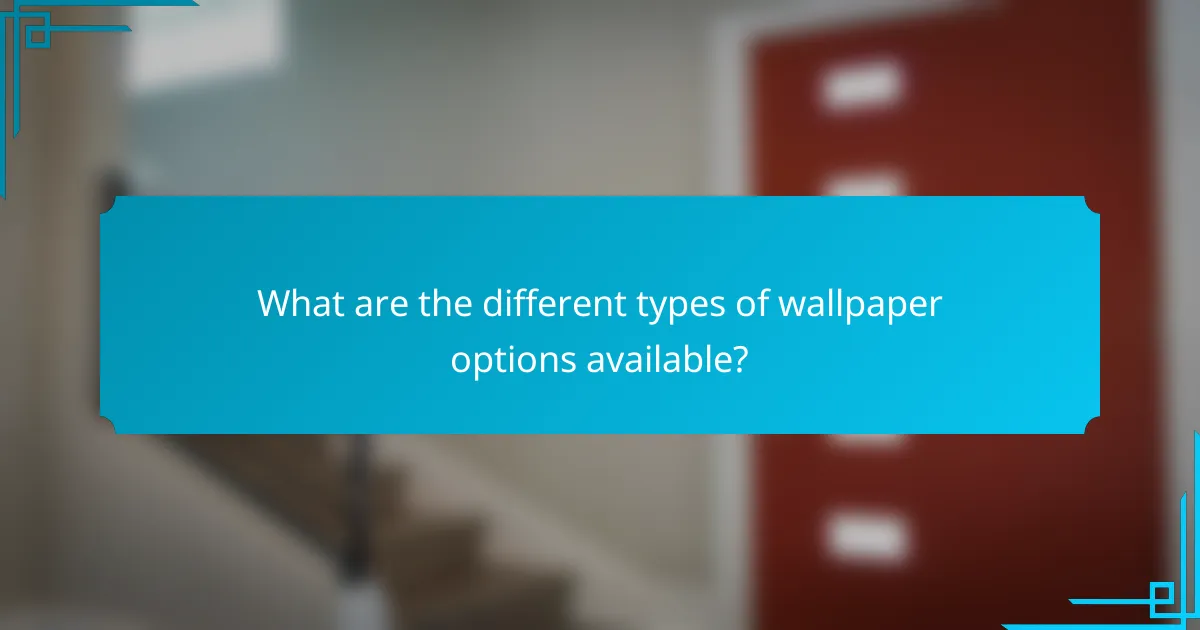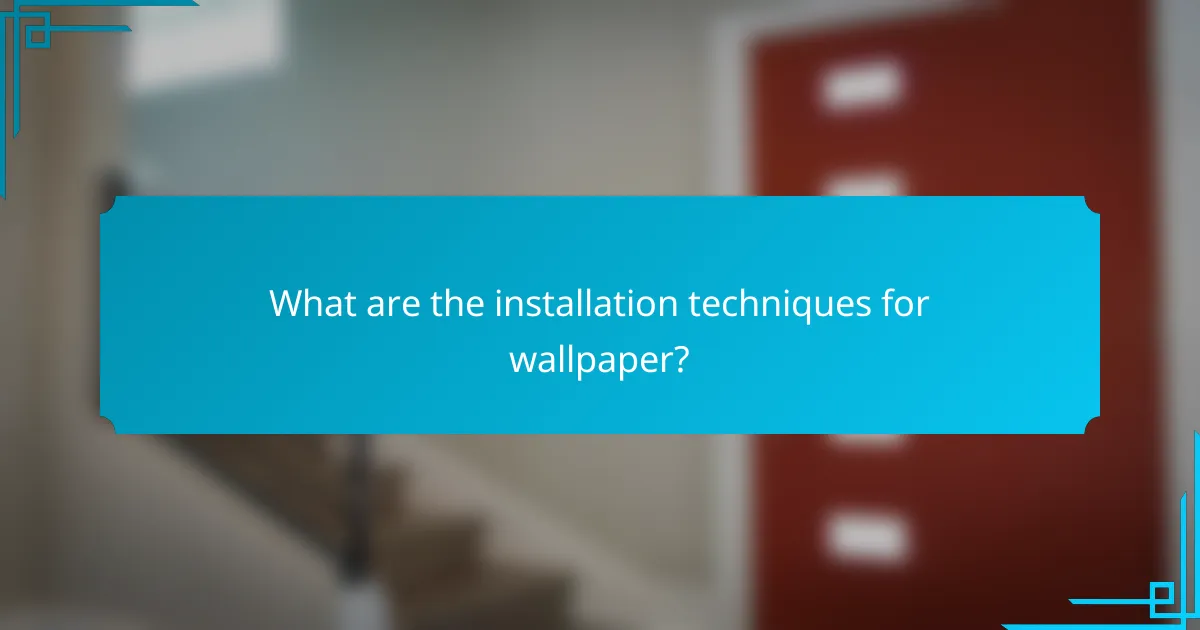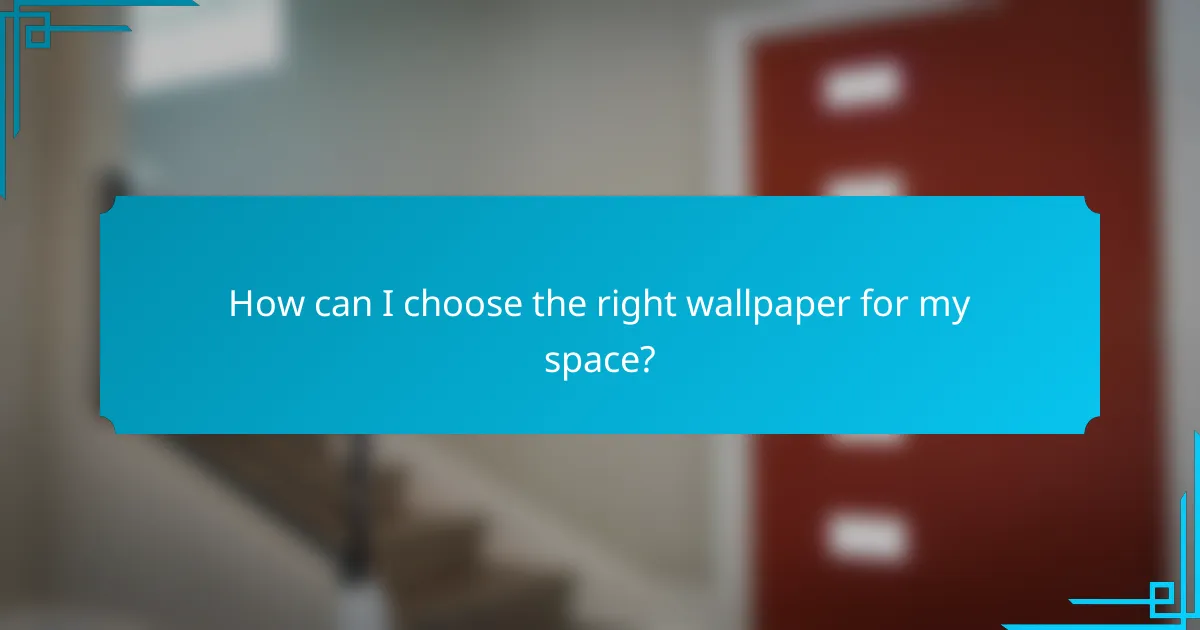Wallpaper options encompass various types, including vinyl, paper, fabric, and non-woven wallpapers, each with distinct characteristics suitable for different environments and design preferences. Installation techniques such as pasting, peel-and-stick, and double-cut methods provide flexibility in application and removal, catering to diverse user needs. Choosing the right wallpaper involves considering factors like room size, lighting, purpose, and existing decor to ensure an aesthetically pleasing and functional outcome. This article provides an overview of these wallpaper types, installation methods, and selection criteria to help readers make informed decisions for their spaces.

What are the different types of wallpaper options available?
The different types of wallpaper options available include vinyl, paper, fabric, and non-woven wallpapers. Vinyl wallpaper is durable and moisture-resistant, making it suitable for kitchens and bathrooms. Paper wallpaper offers a wide range of designs but is less durable. Fabric wallpaper provides a luxurious texture but can be harder to clean. Non-woven wallpaper is easy to install and remove, as it does not require soaking. Each type has unique attributes that cater to various design preferences and functional needs.
How do patterns influence the overall aesthetic of a room?
Patterns significantly influence the overall aesthetic of a room by creating visual interest and establishing mood. They can enhance or detract from the perceived size of a space. For example, large, bold patterns can make a room feel smaller, while small, delicate patterns can create an illusion of spaciousness. Patterns also contribute to the theme or style of a room, whether it’s modern, traditional, or eclectic. They can unify different elements within a space, such as furniture and decor, by providing a cohesive visual language. Additionally, patterns can evoke emotions; warm colors and floral designs often create a cozy atmosphere, while geometric patterns can impart a sense of order and sophistication. The choice of patterns can also reflect personal style, making a room feel more personalized and inviting.
What are the most popular wallpaper patterns currently in use?
The most popular wallpaper patterns currently in use include floral, geometric, and abstract designs. Floral patterns often feature large, vibrant flowers and are favored for their classic appeal. Geometric patterns are popular for their modern look, often incorporating shapes like triangles and hexagons. Abstract designs offer a unique aesthetic, frequently showcasing bold colors and irregular shapes. Stripes remain a timeless choice, providing a sense of height and space. Textured wallpapers, such as those imitating natural materials, are also trending. These patterns cater to various interior styles, enhancing the overall ambiance of spaces.
How do different patterns affect light and space perception?
Different patterns significantly influence light and space perception. Patterns can create visual effects that alter the viewer’s experience of a room. For instance, large, bold patterns can make a space feel smaller and more intimate. In contrast, small, intricate patterns can enhance the sense of openness and airiness. Vertical stripes often draw the eye upward, making ceilings appear higher. Conversely, horizontal patterns can widen the perception of a space. Light colors in patterns reflect more light, contributing to a brighter atmosphere. Dark patterns absorb light, which can make a room feel cozier but also more confined. Research shows that the choice of pattern affects psychological responses, influencing mood and comfort levels in a space.
What role do textures play in wallpaper selection?
Textures significantly influence wallpaper selection by affecting aesthetics and tactile experience. Textures can create depth and visual interest in a space. They also impact how light interacts with the surface, altering the room’s ambiance. For example, a textured wallpaper can make a room feel cozier and more inviting. Additionally, different textures can enhance or soften the overall design theme. Smooth textures may suit modern styles, while rough textures align with rustic themes. The choice of texture can also affect maintenance and durability. Textured wallpapers can hide imperfections on walls, making them practical for certain environments. Overall, textures play a crucial role in determining the final look and feel of a space.
How can texture enhance the tactile experience of a room?
Texture enhances the tactile experience of a room by adding depth and sensory engagement. Different textures can evoke specific feelings, making a space feel warmer or more inviting. For instance, a plush fabric can create a cozy atmosphere. In contrast, smooth surfaces may impart a sense of calm and sophistication. Textural variety can also create visual interest, breaking monotony in design. According to interior design principles, combining textures can lead to a more dynamic environment. The use of textured wallpapers can significantly contribute to this effect, as they invite touch and interaction. Research indicates that tactile elements can influence mood and perception, enhancing overall comfort in a space.
What are the common types of textures found in wallpapers?
Common types of textures found in wallpapers include smooth, embossed, and woven textures. Smooth textures provide a sleek appearance and are easy to clean. Embossed textures add depth and dimension, creating a tactile experience. Woven textures mimic fabric, offering warmth and a cozy feel. Other common textures include matte, metallic, and patterned. Matte textures absorb light, while metallic textures reflect it, adding a touch of glamour. Patterned textures can include floral, geometric, or abstract designs, enhancing visual interest. Each texture serves a unique aesthetic purpose in interior design.

What are the installation techniques for wallpaper?
The installation techniques for wallpaper include pasting, peel-and-stick, and double-cut methods. Pasting involves applying adhesive to the back of the wallpaper before hanging. This method ensures a strong bond and is suitable for most wallpaper types. Peel-and-stick wallpaper has a self-adhesive backing, allowing easy application and removal. It is ideal for renters or temporary decor. The double-cut method involves overlapping two strips and cutting through both layers to create a seamless edge. This technique is often used for matching patterns. Each method requires careful preparation of the wall surface for optimal results.
How do different installation methods affect the longevity of wallpaper?
Different installation methods significantly affect the longevity of wallpaper. Professional installation typically ensures better adhesion and alignment. This minimizes the risk of peeling or bubbling over time. Conversely, DIY methods may result in uneven surfaces. Poor adhesion can lead to premature wear and tear. For example, using paste vs. peel-and-stick can yield different durability outcomes. Paste provides a stronger bond, while peel-and-stick may lift easily. Proper surface preparation also plays a crucial role in longevity. Clean, smooth surfaces enhance wallpaper lifespan. Overall, the choice of installation method directly impacts wallpaper durability and maintenance needs.
What are the steps involved in traditional wallpaper installation?
The steps involved in traditional wallpaper installation include preparation, measuring, cutting, applying adhesive, hanging the wallpaper, and finishing. First, prepare the wall by cleaning it and repairing any imperfections. Next, measure the wall to determine how much wallpaper is needed. Cut the wallpaper into appropriate lengths, allowing for pattern matching. Apply adhesive to the back of the wallpaper or directly to the wall, depending on the type of wallpaper. Hang the wallpaper from the top down, smoothing out air bubbles as you go. Finally, trim any excess wallpaper at the edges and clean up the workspace. These steps ensure a successful installation of wallpaper.
How does peel-and-stick wallpaper differ in installation process?
Peel-and-stick wallpaper differs in installation process by eliminating the need for paste or glue. This type of wallpaper features an adhesive backing that allows for easy application. Users simply peel off the backing and stick the wallpaper directly to the wall. This process is generally quicker than traditional wallpaper installation. Additionally, peel-and-stick wallpaper can be repositioned before it fully adheres. This feature makes it more forgiving for beginners. Traditional wallpaper requires precise measurements and often involves soaking the paper in water. In contrast, peel-and-stick wallpaper is ready to use immediately upon peeling. This difference significantly reduces preparation time and complexity.
What tools and materials are necessary for wallpaper installation?
The tools and materials necessary for wallpaper installation include wallpaper, adhesive, a utility knife, a straightedge, a wallpaper brush, a seam roller, and a smoothing tool. Wallpaper serves as the primary decorative element. Adhesive is required to secure the wallpaper to the wall. A utility knife is essential for cutting the wallpaper to size. A straightedge helps ensure straight cuts and alignments. A wallpaper brush is used to smooth out air bubbles. A seam roller is important for pressing down seams for a seamless look. A smoothing tool assists in applying pressure and ensuring proper adhesion. These items are standard in wallpaper installation practices.
Which adhesives are best suited for different wallpaper types?
Vinyl wallpaper requires a strong adhesive, often a paste specifically designed for vinyl. Non-woven wallpaper is best applied with paste-the-wall adhesive, allowing for easy repositioning. Paper wallpaper typically uses a traditional wallpaper paste for secure adhesion. For fabric wallpaper, a heavy-duty adhesive is recommended to support its weight. Grasscloth wallpaper benefits from a clear adhesive to avoid altering its natural look. Each adhesive type is formulated to match the unique properties of the wallpaper material, ensuring optimal performance and durability.
What tools are essential for a successful wallpapering project?
Essential tools for a successful wallpapering project include a wallpaper brush, smoothing tool, utility knife, and measuring tape. A wallpaper brush helps apply adhesive evenly and removes air bubbles. A smoothing tool, often made of plastic, ensures a flat surface during application. A utility knife is crucial for trimming excess wallpaper accurately. Measuring tape allows for precise measurements of wall dimensions. A level ensures that wallpaper is hung straight. A seam roller can help press down seams for a seamless finish. These tools collectively enhance the efficiency and quality of the wallpapering process.

How can I choose the right wallpaper for my space?
To choose the right wallpaper for your space, assess your room’s size and lighting. Dark colors can make a small room feel smaller. Light colors create an illusion of space. Consider the room’s purpose; vibrant patterns suit playrooms, while subtle designs work for bedrooms. Match wallpaper style to existing decor for cohesion. Texture adds depth; smooth finishes suit modern styles, while textured wallpapers fit traditional themes. Sample swatches in your space to see how they interact with light. This approach ensures the wallpaper enhances your environment effectively.
What factors should be considered when selecting wallpaper?
When selecting wallpaper, consider the room’s purpose and lighting. Different colors and patterns can influence mood. Durability is essential for high-traffic areas. Texture can add depth and interest to a space. The ease of installation and removal affects long-term satisfaction. Additionally, consider the maintenance and cleaning requirements of the wallpaper. Finally, budget constraints will determine the range of options available.
How do color and pattern impact the mood of a room?
Color and pattern significantly impact the mood of a room. Different colors evoke specific emotions; for instance, blue promotes calmness while red stimulates energy. Patterns can influence perception of space; large patterns may make a room feel smaller, while small patterns can create a sense of spaciousness. Research shows that warm colors like yellow and orange can create a welcoming atmosphere. In contrast, cool colors like green and blue can enhance relaxation. The choice of patterns also contributes to the overall aesthetic; geometric patterns can convey modernity, while floral designs may evoke a sense of comfort. Studies indicate that individual preferences play a role in emotional responses to color and pattern. Thus, understanding these effects allows for intentional design choices that enhance the desired mood in a space.
What is the importance of measuring wall space before purchase?
Measuring wall space before purchase is crucial for ensuring the correct fit of wallpaper. Accurate measurements prevent waste and additional costs associated with excess material. Knowing the dimensions helps in selecting the right amount of wallpaper needed. It also allows for planning the pattern alignment effectively. Without proper measurements, buyers risk purchasing insufficient or excessive wallpaper. This can lead to mismatched patterns or incomplete coverage. Therefore, measuring wall space is essential for a successful wallpaper installation project.
What are some common mistakes to avoid when installing wallpaper?
Common mistakes to avoid when installing wallpaper include not preparing the wall surface properly. Uneven or dirty walls can lead to poor adhesion. Another mistake is failing to measure accurately. Incorrect measurements can result in wasted material and mismatched patterns. Not using a level can cause the wallpaper to hang crookedly. Additionally, neglecting to use the right adhesive can affect the wallpaper’s longevity. Overlapping seams or not aligning patterns correctly can create an unprofessional look. Finally, rushing the installation process can lead to mistakes that are difficult to fix later.
How can I ensure a smooth and bubble-free application?
To ensure a smooth and bubble-free application of wallpaper, start with a clean, dry surface. This prevents imperfections from affecting the adhesion. Next, use a high-quality adhesive suitable for your wallpaper type. Apply the adhesive evenly and avoid excess. When positioning the wallpaper, use a smoothing tool to eliminate air bubbles. Work from the center outwards to push air towards the edges. If bubbles persist, gently lift the wallpaper and re-smooth. Allow adequate drying time as specified by the adhesive manufacturer. Following these steps minimizes the risk of bubbles and ensures a professional finish.
What should I do if I encounter issues during installation?
If you encounter issues during wallpaper installation, first check the manufacturer’s instructions. Ensure you are using the correct adhesive for your wallpaper type. Inspect the wall surface for any imperfections that may affect adhesion. If bubbles appear, gently smooth them out with a wallpaper brush. For misaligned seams, carefully peel back and reposition the wallpaper. If the wallpaper tears, use a small amount of adhesive to secure the torn piece. Always have a seam roller on hand to ensure proper adhesion along seams. If problems persist, consult a professional for assistance.
What are the best practices for maintaining wallpaper?
Regularly clean wallpaper with a soft cloth or sponge. Use a mixture of mild soap and water for stubborn stains. Avoid harsh chemicals that can damage the surface. Ensure the room has proper ventilation to prevent moisture buildup. Repair any tears or peels promptly to maintain appearance. Consider using a protective coating for added durability. Monitor for mold or mildew, especially in humid areas. Replace wallpaper every 5 to 10 years for a fresh look.
The main entity of the article is wallpaper, which encompasses various types, patterns, textures, and installation techniques. The article provides an overview of different wallpaper options such as vinyl, paper, fabric, and non-woven varieties, detailing their unique attributes and applications. It explores how patterns impact the aesthetic and perception of space, as well as the role of texture in enhancing the tactile experience of a room. Additionally, the article outlines installation methods, necessary tools, and best practices for maintaining wallpaper, ensuring readers have comprehensive guidance for selecting and applying wallpaper effectively.